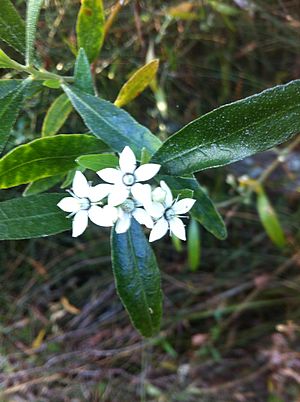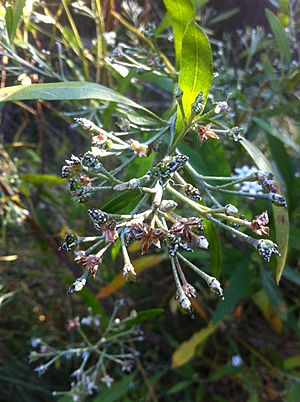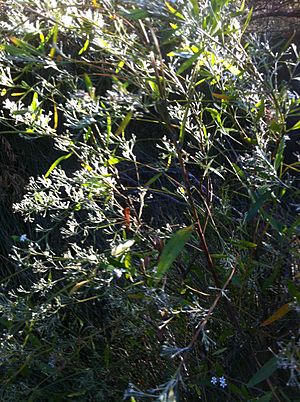Blister bush facts for kids
Quick facts for kids Blister bush |
|
|---|---|
 |
|
| Rhadinothamnus anceps flowers | |
| Scientific classification | |
| Kingdom: | |
| (unranked): | |
| (unranked): | |
| (unranked): | |
| Order: | |
| Family: | |
| Genus: |
Rhadinothamnus
|
| Species: |
R. anceps
|
| Binomial name | |
| Rhadinothamnus anceps (DC.) Paul G.Wilson
|
|
| Synonyms | |
|
Phebalium anceps Phebalium argenteum |
|
Rhadinothamnus anceps, often called the blister bush, is a type of shrub. It belongs to the genus of plants known as Rhadinothamnus. This plant is special because it only grows in Western Australia.
What Does It Look Like?
This slender shrub usually grows to be about 1 to 3 meters (3 to 10 feet) tall. Its young branches have a slightly angled shape. They are covered with tiny, shiny silver scales.
The leaves grow in an alternating pattern along the stem. They are a pale, silvery-green color and feel like paper. Each leaf has a short stem called a petiole. The leaf itself is narrow and oval-shaped. It can be 40 to 120 millimeters (1.5 to 4.7 inches) long and 8 to 23 millimeters (0.3 to 0.9 inches) wide.
If you crush the leaves, they release a strong smell, a bit like mango. It's important to be careful when touching the leaves. They can cause blisters on your skin.
Flowers and Fruit
The blister bush blooms with white flowers between August and December. These flowers grow on small stalks called pedicels. They appear in clusters at the ends of branches and where leaves meet the stem.
Each flower has a cup-shaped base called a calyx. This calyx is silver and about 1 to 1.5 millimeters long. It has five small, triangle-shaped parts. There are also five separate white petals. These petals are broadly oval and measure about 4.5 to 6 millimeters long.
After the flowers, the plant forms fruit. The fruit has five smooth sections. Each section is slightly pointed and about 3 millimeters long. Inside, you'll find flat, oval-shaped seeds.
Where Does It Grow?
The blister bush is found in Western Australia. It likes to grow near creeks and in swampy areas. You can find it along the coast in regions like the Swan Coastal Plain and South West.
Its range stretches from Yanchep in the north to just east of Albany in the south. It grows well in dark, peaty, sandy soils. This plant is found in several special natural areas, including the Esperance Plains and Jarrah Forest.
How Was It Named?
The blister bush has had a few different scientific names over time. It was first described in 1824 by a botanist named Augustin Pyramus de Candolle. He called it Phebalium anceps.
Then, in 1825, another botanist, Kurt Polycarp Joachim Sprengel, reclassified it. He gave it the name Eriostemon anceps.
Finally, in 1998, Paul G.Wilson placed the plant in its current group. He named it R. anceps in an article published in the journal Nuytsia. This is the name it is known by today.



